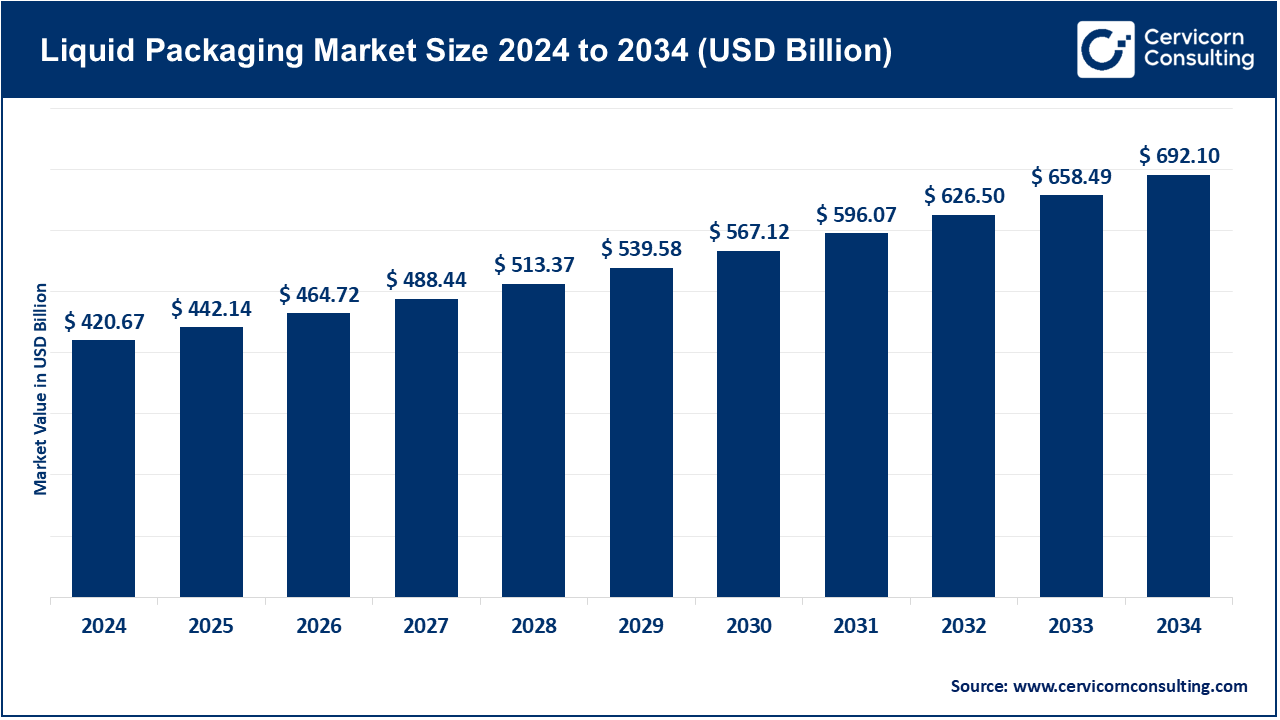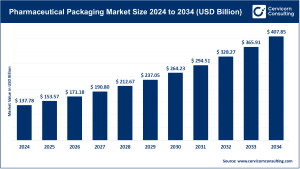Liquid Packaging Market Overview
The liquid packaging market represents an essential branch of the broader packaging industry, catering to a wide range of liquid products such as dairy, juices, edible oils, sauces, pharmaceuticals, and cosmetics. In 2024, the market reached a valuation of USD 420.67 billion and is expected to rise to nearly USD 692.10 billion by 2034, advancing at a CAGR of 5.1% during 2025–2034. This steady growth is fueled by increasing consumer demand for convenient, sustainable, and safe packaging formats, particularly within the food and beverage, pharmaceutical, and personal care segments.
Get a Free Sample: https://www.cervicornconsulting.com/sample/2738
Key Market Trends
1. Sustainability and Circular Packaging
The shift toward eco-conscious packaging has accelerated, with both consumers and regulators favoring solutions that minimize environmental impact. This has led to greater use of recyclable paperboard, mono-material films, and biodegradable laminates. Market leaders like Tetra Pak and Elopak are innovating with fully renewable cartons and fiber-based designs. Moreover, regulations such as the EU Packaging and Packaging Waste Regulation (PPWR) are reshaping investment priorities and packaging development.
2. Growth in Aseptic and Shelf-Stable Packaging
Rising demand for long-shelf-life beverages and alternatives to traditional dairy has strengthened the adoption of aseptic packaging. Advances in aseptic processing and filling technologies now allow manufacturers to extend shelf life without relying on cold storage, cutting logistics costs. SIG Combibloc’s modular filling platforms illustrate this trend, enabling quick product changes while maintaining efficiency.
3. Convenience and Portability
With modern lifestyles driving on-the-go consumption, there is a surge in demand for single-serve packs, flexible pouches, and resealable spouts. Growth in e-commerce and retail chains has further increased the need for lightweight, durable, and easy-to-transport packaging, which also helps manufacturers reduce freight costs.
4. Smart Manufacturing and Digital Integration
Digitalization is transforming liquid packaging. Technologies such as predictive maintenance, product traceability, and automation are being incorporated into packaging processes. These innovations not only boost operational efficiency but also ensure greater product safety and compliance.
5. Emphasis on Food Safety and Regulations
Tighter global food safety standards for dairy, beverages, and pharmaceuticals are pushing investments in sterilization, high-barrier films, and tamper-proof closures. These regulatory-driven upgrades reduce spoilage, enhance brand trust, and open access to international markets.
Market Drivers
1. Rising Demand for Ready-to-Drink and Shelf-Stable Products
Urbanization and higher disposable incomes, especially in Asia-Pacific and Latin America, are driving growth in packaged beverages. This has increased adoption of aseptic cartons and flexible formats that guarantee convenience and hygiene.
2. Government Push for Sustainable Packaging
Policies such as Extended Producer Responsibility (EPR) programs and green packaging incentives are compelling manufacturers to invest in recyclable, renewable, and fiber-based formats.
3. Advancements in Technology
Breakthroughs in aseptic filling, sterilization methods, and high-barrier materials allow extended shelf life with fewer resources. Smart packaging technologies further streamline operations and improve traceability.
4. Shift Toward Lightweight Packaging
Manufacturers are moving to lightweight cartons, laminates, and pouches, which reduce shipping costs and carbon emissions while aligning with sustainability expectations.
5. Growth of E-Commerce and Retail
The boom in online grocery and beverage sales has created demand for sturdy packaging that protects liquids during transport without compromising product quality.
Impact of Trends and Drivers
-
By Product Segment: The strongest growth is seen in aseptic cartons, flexible pouches, and bag-in-box systems, reflecting the combined demand for convenience, sustainability, and extended shelf life.
-
By Region:
-
Asia-Pacific is the fastest-growing region, led by urbanization, rising income levels, and beverage consumption.
-
Europe remains a mature market where regulatory policies are encouraging rapid adoption of recyclable and fiber-based solutions.
-
North America is benefiting from strong e-commerce penetration and heightened interest in sustainability-driven packaging.
-
-
By Application: Key beneficiaries include dairy products, plant-based beverages, pharmaceuticals, and personal care liquids, all of which increasingly require recyclable and aseptic packaging solutions.
Challenges & Opportunities
Challenges:
-
Elevated costs of sustainable raw materials and production
-
Rising competition from alternatives such as flexible plastics
-
Complex regulatory requirements across different geographies
Opportunities:
-
Expansion potential in India, Brazil, and Southeast Asia where demand for packaged liquids is booming
-
Wider adoption of circular economy principles and renewable solutions
-
Growth in digital packaging technologies to improve traceability and efficiency
Future Outlook
Sustainability will remain the dominant driver, alongside digital innovation and consumer demand for portable, safe, and convenient formats. Companies investing in renewable materials, advanced manufacturing technologies, and consumer-centric packaging will be best positioned to capture growth, particularly across Asia-Pacific and Latin America, which are set to lead the market over the next decade.
Contact Us for a Detailed Overview: https://www.cervicornconsulting.com/contact-us


